
The Scorpio constellation can be found in the southern part of the sky and is a prominent feature of the zodiacal circle. While it may not be the largest constellation, it holds great significance. Ranking as the 33rd largest constellation by area, Scorpio is situated alongside other well-known constellations such as Libra, Sagittarius, and Wolf. Its name is derived from its distinct curved shape, reminiscent of a scorpion’s tail.
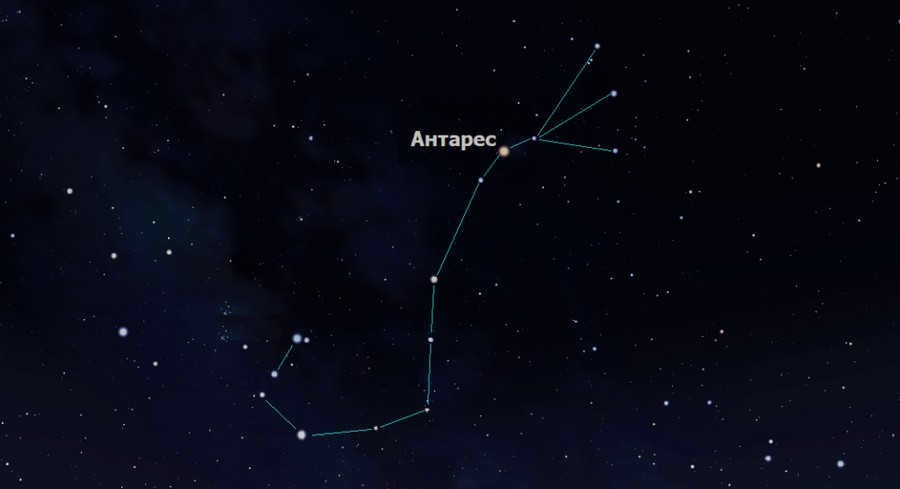
Legends and Myths
In Greek mythology, there is a tale about Artemis, the forever youthful goddess of fertility and hunting, who happens to be the daughter of Zeus. According to the story, Artemis had a disagreement with the hunter Orion, and as a result, she decided to punish him. She summoned a scorpion to sting him, and the creature successfully carried out her command. In gratitude for its assistance, Artemis transformed the scorpion into a constellation.

Stars in the Scorpio Constellation
Antares, the brightest star in the Scorpio constellation, is known as Alpha. Its name means “rival of Ares,” referring to Mars. This massive red supergiant is similar to Mars, but much larger. Antares is 700 times the size of our Sun, making it one of the largest stars in the sky. It is part of a binary system, with a smaller bluish-white star as its neighbor.
Another bright star in Scorpio is Lambda, located in the tail and representing a sting. It is a triple system called Shaula, consisting of a subgiant and two satellites.
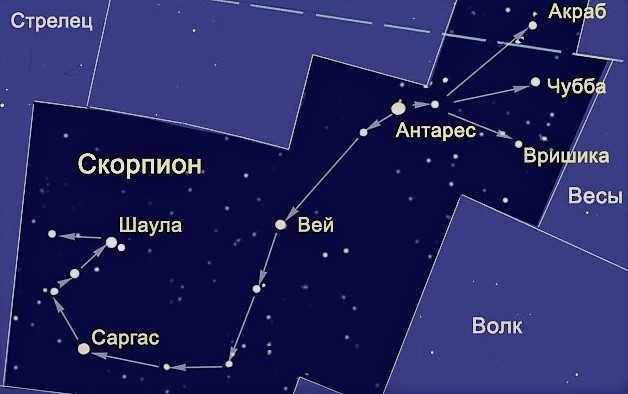
Following that is Theta, Sargas. It is alternatively known as Sargon. The term originates from the Sumerian language, although its precise significance remains a mystery. Sargas is a binary system consisting of a yellow giant and a companion.
Delta Scorpius is yet another binary star. Its name, Dshubba, translates to “forehead of the scorpion.”
Epsilon Scorpius has never received an official designation. Patrick Moore proposed the name Wei, but it was already assigned to a Chinese asterism that encompasses various stars within the same constellation, including Epsilon.
Fascinating fact: Epsilon Scorpio is depicted on the flag of Brazil. It represents the state of Ceará.


Hirtab is the name of a double star known as Kappa. It is composed of a variable star and its companion, and is part of the asterism known as the Scorpio Tail.
The Beta constellation has multiple names, one of which is shared with Xi – Graffias. It is also referred to as Raffias, which translates to “crab” in Greek, and Aqrab, which means “scorpion” in Arabic. It is composed of a pair of blue-white luminaries, making it a double star.
An-Niyat, also known as Tau Scorpius, is a potential supernova candidate. Similar to Beta, it is a blue-white giant, but only a single one.
Sigma, another star, shares its name with Tau. It is a multiple system and has the same composition as Beta.
The final fascinating star in the constellation is Nu. The grouping known as Jabbah (“crown on the forehead”) is comprised of a total of seven elements. Within it is a quadruple star, which has been hailed as one of the most stunning examples of such systems in the celestial sphere.
Additional entities
In the Scorpius constellation, there is a plethora of fascinating entities: nebulas, asterisms, clusters, and more. One example is the Butterfly cluster, which earned its name due to its uncanny resemblance to the insect. Another cluster, the Ptolemy globular cluster, was named after the scientist who first discovered it, despite his initial belief that it was a nebula. However, the constellation of Scorpius boasts many other intriguing objects, such as the Cat’s Paw and Beetle clusters, as well as the War and Peace nebula (NGC 6357). Additionally, one can find the Scorpion’s Sting and Cat’s Eyes asterisms in this region.
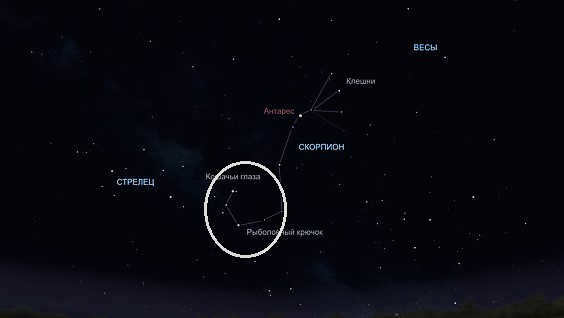
Scorpius Constellation Observation
The Scorpius constellation is easily visible in the night sky throughout Russia. It can be observed at almost any time, except for a brief period between November 23 and 29 when the Sun passes through it in a remarkably short six days. However, astronomers consider the best time for observation to be during the months of May and June. It is recommended to conduct observations at latitudes ranging from +45 to -90 degrees.
Antares, a star ranked among the top 20 in terms of brightness, is a significant component of the constellation. This red M-class supergiant is currently in its final stages of life, as it consumes the last remaining reserves of hydrogen in its core. The exact timeframe for when this celestial body will explode remains uncertain, as it could occur at any moment within the next million years.
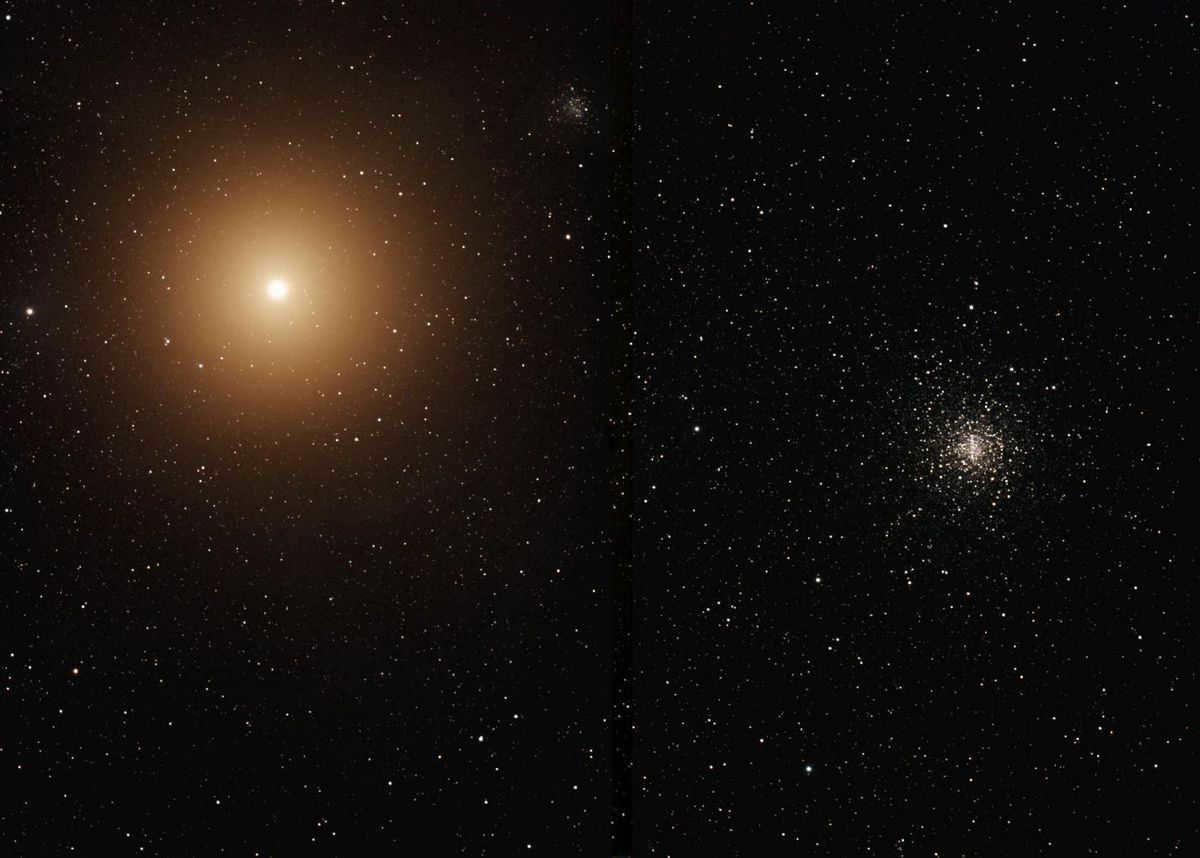
Overview
Antares is located approximately 550-600 light-years away from our solar system. It holds the distinction of being the most luminous star in the constellation Scorpius and ranks as the 15th (or 16th if we consider the individual components of Capella as separate objects) brightest celestial body visible in the night sky.
Physical and orbital characteristics
The star has different physical and orbital characteristics compared to the Sun:
- The star is 10 thousand times brighter than the Sun;
- It has a diameter that is 400 times larger than the Sun;
- The star’s mass exceeds the Sun’s mass by 17 times (according to other data, it exceeds by 12 times).
Antares has a colder surface temperature than the Sun, measuring about 3100 º C. However, it emits a significant amount of infrared energy, surpassing the Sun by 65 thousand times in this aspect.
The star travels through space at a speed of almost 21 km/s. Its trajectory takes it through the Milky Way, approximately 21000-24000 light years away from the center of our galaxy.
The system of stars
Antares is accompanied by a companion star that appears blue-white in color (although it may sometimes appear green due to cosmic winds). This companion star was first observed by Austrian astronomer I. T. Bürg in 1819, but its existence was officially confirmed in 1849.
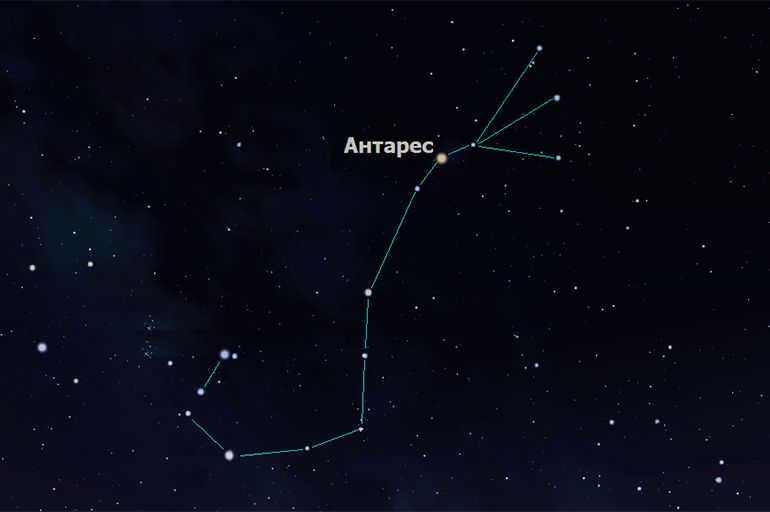
Due to the brightness of the primary star, the companion celestial body is challenging to observe, despite its considerable size. With a magnitude of 5, Antares-B, as it is called, is comparable in size to our own Sun. The best opportunity to view Antares-B is when the primary star is fully obscured by the Moon’s disk, but this window of time lasts only a few seconds. Additionally, during the transition from November to December, both stars temporarily disappear from the Earth observer’s view, seeming to blend into the surrounding sunlight.
Location in the sky
Antares can be seen in the sky from late spring to early fall for observers on Earth in the Northern Hemisphere. The star is not very high above the southern horizon, especially in more northern regions. To the right of Antares is the Messier-4 star cluster, but it is only visible in the tropics and subtropics. In middle latitudes, it may not fully rise above the horizon. However, in the Southern Hemisphere, Antares is visible all year round.
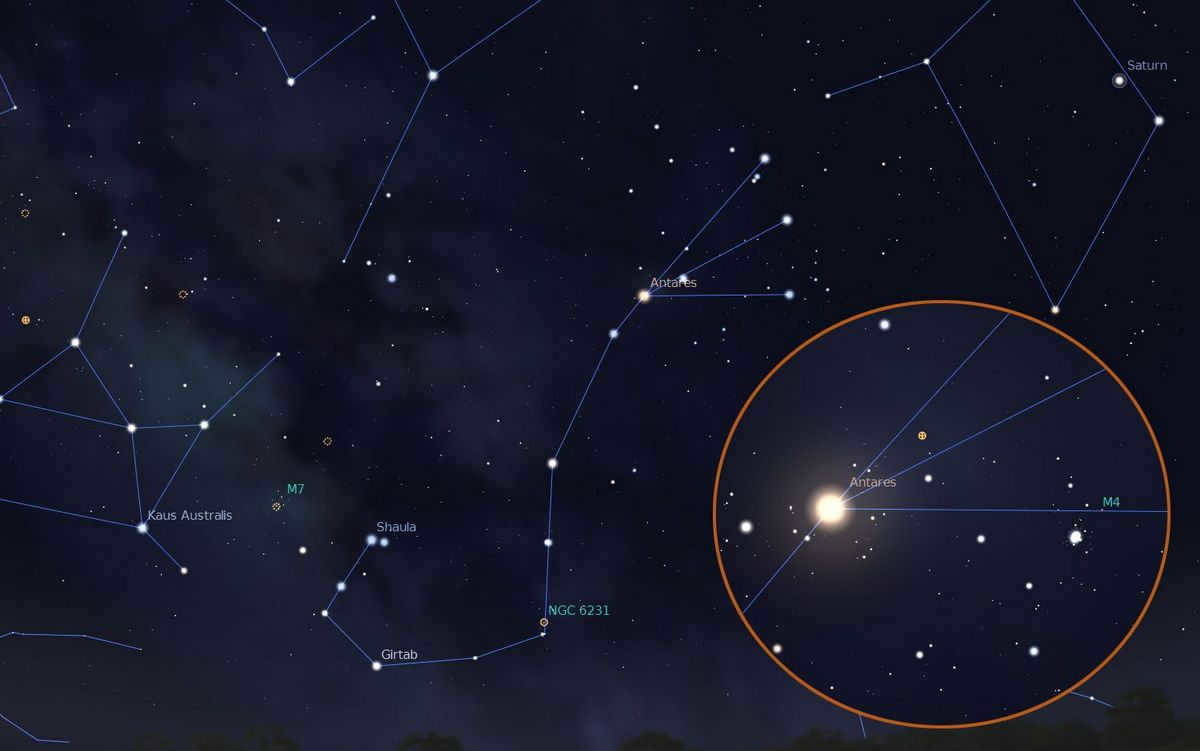
By recognizing the appearance of the constellation Scorpius, locating Antares becomes effortless as it occupies the position of the head in the traditional representation of the arachnid. The Scorpio Sting asterism commences in close proximity to this particular star.
Fascinating Trivia
The star’s name, when translated from ancient Greek, means “Anti-Ares” or “Not-Mars” (or “Rival of Mars”). This name was given to the celestial body because it is as bright and red as the fourth planet from the Sun, but it is a distinct entity. Antares is also referred to by various names in different cultures and scientific writings:
- Kalb al-Aqrab (or Heart of Scorpio) – according to Arabic astronomical tradition;
- Satevis – in ancient Persia;
- Selkid – in Egyptian culture;
- Jyeshtha – in ancient India;
- Vespertelino – in medieval Italy;
- Rehua – in Māori culture.
The initial high-resolution images of the star were finally released in 2017, captured by the state-of-the-art Very Large Telescope situated at the Parnall Observatory in Chile. These groundbreaking visuals allowed astronomers to create a comprehensive map of the celestial object and accurately measure the movement parameters of its surface layers. Additionally, extensive turbulent regions were identified, indicating the presence of strong cosmic winds that are causing a rapid decrease in the star’s mass.
< p >In the sky, there exists an antipode of Antares. It takes the form of Aldebaran, a star of similar size and hue, positioned almost exactly opposite the alpha of Scorpius on the zodiacal circle. As a result, these two stars cannot be observed simultaneously from any location on Earth, except for a few days per year when they barely emerge above the horizon.< /p > < p >Out of all the celestial objects of the first stellar magnitude, such as Altair, Procyon, and Sirius, Antares is the farthest from each of them compared to the distances separating the other luminaries in this category. The nearest star to Antares is Alpha Centauri, but due to its high intrinsic velocity, these two cosmic entities are constantly moving away from one another.< /p >

Located in the southern region of the sky is the Scorpius constellation, which brings together numerous bright stars. As we know, this is one of the 12 constellations of the zodiac. This particular region spans 497 square degrees, making it not the largest, but still significant in terms of its occupied area.
The Scorpius constellation is surrounded by Sacristan and Serpentor, and is situated between Libra and Sagittarius. It also shares borders with the Wolf, the Naugol, and the Southern Crown.
It is believed that the constellation was named based on its resemblance to the head, body, and curved tail of a scorpion.
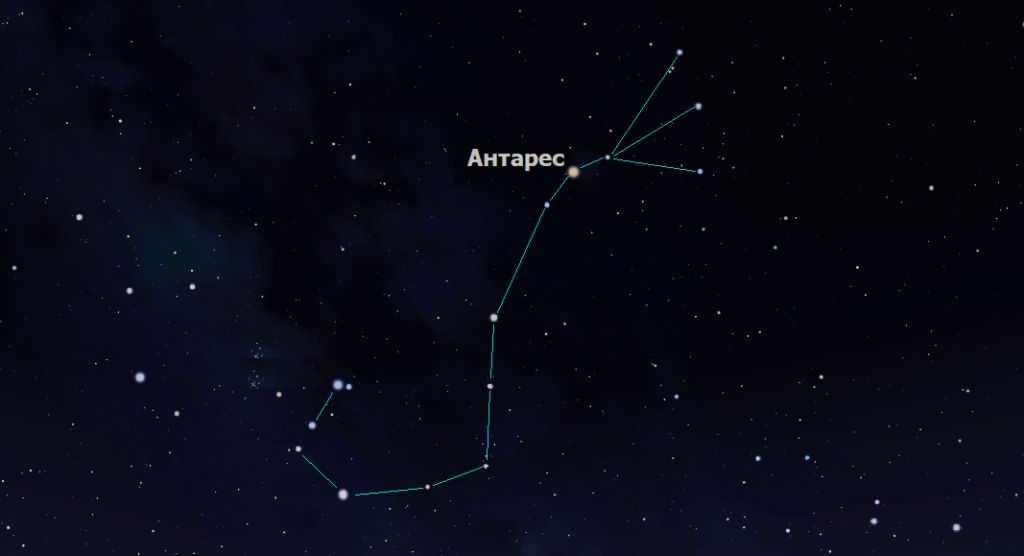
Legend of the Scorpio Constellation
As the story goes, Zeus had a daughter named Artemis who was known for her hunting skills, but also for her vengeful nature. One fateful day, Artemis found herself in a heated argument with Orion. Consumed by anger, she decided to take revenge by sending a scorpion to sting Orion’s heel. In a twist of fate, Artemis later felt gratitude towards the scorpion for carrying out her wishes, and transformed the creature into a constellation as a sign of appreciation.

The stars of the Scorpius Constellation
Alpha in Scorpius is known as Antares. Interestingly, its position marks the heart of the scorpion figure. In reality, it is a binary system composed of red and blue-white supergiants.
Beta is a multiple star system called Aqrab. It is often associated with the scorpion’s claws.
Lambda, also known as Shaula, represents a triple star system. Lambda is said to represent the scorpion’s raised tail.
Delta, or Jubba, is a star with a companion. Its name translates to “forehead”.
Theta is a yellow giant star. Like the previous star, it also has its own satellite.
Epsilon is a massive variable, while Kappa–Hirtab is a binary star system.
For instance, in the constellation Scorpio, Pi, Nu, and Xi are multiple star systems.
Iota consists of a single evolved star and a supergiant.
Sigma is part of a complex system of stars, like many others in the constellation. However, there is a stellar dwarf called Tau with a strong magnetic field.
On the other hand, Ypsilon and Eta are subgiants.
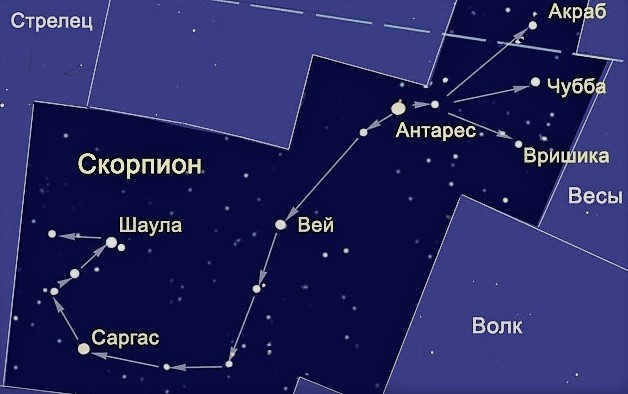
Within the Scorpius constellation lies the remarkable star, U Scorpius. What sets it apart? It stands as one of ten recurring novae that are widely recognized in the Milky Way. Astronomers have noted its exceptional speed.
G Scorpio, on the other hand, shines as a magnificent orange giant.
Now, let’s turn our attention to Omega, which consists of a pair of luminaries—a dwarf and a giant. Zeta is similarly divided, boasting a hypergiant and an orange giant.
Rho presents itself as a binary system, with a subgiant as its primary component. Interestingly, Mu isn’t just two stars, but two entire star systems.
Clearly, Scorpius is home to numerous complex systems. Additionally, there are quite a few individual stars scattered throughout the constellation. Undoubtedly, each one presents a fascinating object in its own right.
I have stars in the sky, but I yearn greatly for the unlit little lamp in my dwelling.
"Rabindranath Tagore"
Celestial entities
Messier 6, also known as the Butterfly, is a dispersed assemblage of stars. Its shape is said to resemble that of a flying insect.
Furthermore, astronomers have uncovered multiple globular clusters in the specified section of the heavens. Notably, this includes Messier 4, where they were first able to distinguish individual stars.
For instance, this is also the location where Ptolemy’s cluster was discovered. It obtained its name from the scientist who initially detected it. Although he initially believed the object to be a nebula, it was later classified as a cluster. It is situated near the sting.
One of the densely populated globular clusters can be found in the constellation Messier 80, and it is accompanied by the following nebulae:
- The Cat’s Paw
- The Butterfly, or Beetle
- NGC 6072
- NGC 6357, known as War and Peace
Asterisms in the Scorpius constellation
The peculiar arrangement of bright stars in the tail region forms The sting of the scorpion. It is believed that the alpha star of Scorpius, Antares, serves as the starting point for this formation. The abundance of stars that make up the sting creates a shape that is more similar and clearly defined.
In modern astronomy, the sting is often compared to a fishing hook, most likely due to the twisted appearance of the stars resembling this object.
Furthermore, within the constellation, there exists a distinct asterism called Cat’s Eyes. This particular formation is comprised of the stars Lamb and Epsilon, which are situated at the terminus of the tail.


Stargazing
Due to its proximity to the center of our galaxy, the constellation Scorpius is easily visible in the night sky. The Sun moves through this constellation the fastest, with its journey taking place from November 23 to 29, as recorded by astronomers.
However, the optimal time for observing Scorpius is considered to be during the months of May and June.
As one of the oldest and most well-known celestial formations, Scorpio’s bright stars have served as a navigational point for our ancestors.
The name of the constellation Scorpius is fully justified by its appearance, as the clear outlines of the venomous arthropod can easily be seen without even looking closely. This name was given to the constellation in ancient times. Scorpio is home to many of the brightest stars in the night sky. Those who are born under this sign are known for their perseverance and hard work.
Even today, scientists continue to closely study the stars in this constellation, as they constantly surprise us with new discoveries. Many legends have been created in honor of this constellation, which have been passed down to us from ancient times.
Observing the bright stars in this constellation is a delight, as they hold centuries-old secrets and a mysterious history.
10. The constellation can be seen completely in the southern part of Russia and partially in the central region
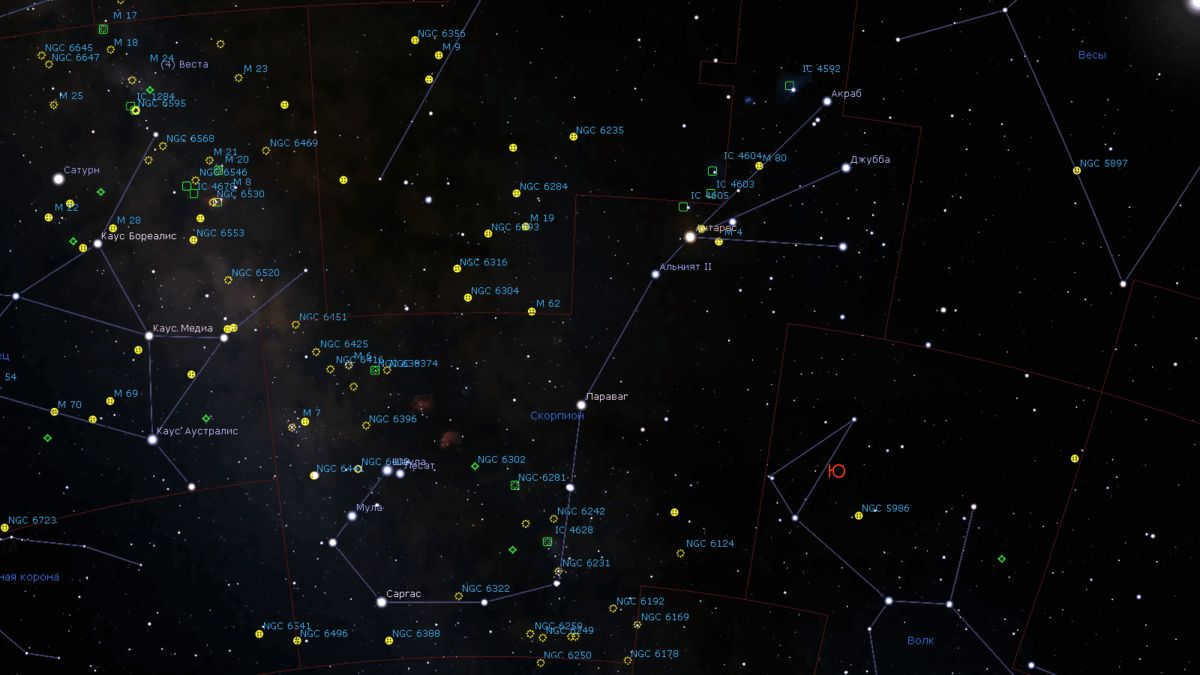
Southern regions can take pride in having access to the Scorpius constellation throughout the year. It is a remarkable fact that the star θ Scorpius is visible in southern areas exclusively, making it a unique sight for those living in the south.
The Scorpius constellation can be satisfactorily observed in the central regions of Russia. The most brilliant star of this constellation is well visible to residents in the south and the Urals. As a result, the majority of the population in our country can witness the constellation during certain months. Unfortunately, this captivating sight is not available year-round for those living in the northern regions.
9. The legend of Orion’s encounter with the venomous scorpion

Legends, myths, and tales abound about this particular constellation. Among the ancient Greeks, there was a myth about Orion, a renowned hunter known for his strength and his penchant for boasting. He would frequently boast about his power, claiming that he could overcome and triumph over any living creature on Earth. However, his arrogance turned the Greek gods against him.
The goddess Artemis, in particular, was enraged by his audacity. In response, she set a scorpion upon him, which stung Orion and caused his demise. Although the braggart met his end, Poseidon was able to convince Zeus to place Orion in the sky, far away from the Scorpion. This is why these two constellations are widely separated in the night sky.
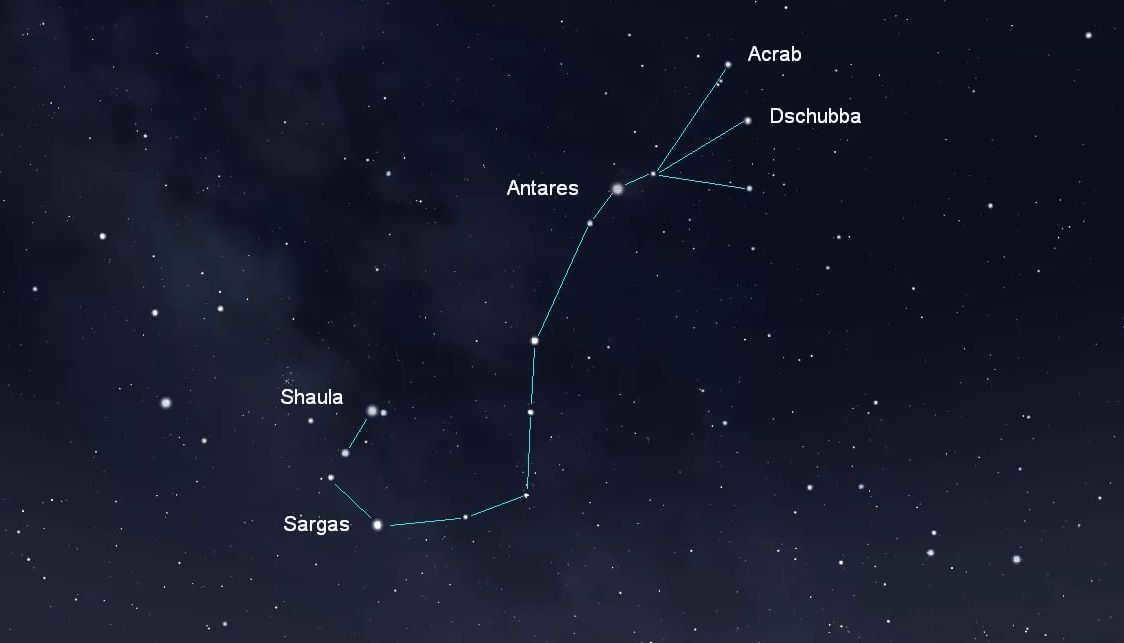
Scorpio is home to numerous brilliant stars, with Antares, Shaula, and Sargas being the most prominent. Antares, situated 600 light years away from Earth, shines as the brightest star in Scorpius. Its radiance is most pronounced when observed from the southern regions of our native land.
Shaula, slightly dimmer than Antares, is located in the tail of Scorpius. Its name, derived from Arabic, translates to “raised,” referring to its position in the tail. Sargas, also known as Theta Scorpio, is an ancient star with an unknown meaning behind its name. It is sometimes referred to as Girtab.
7. One of the stars listed in the Almagest catalog by Claudius Ptolemy
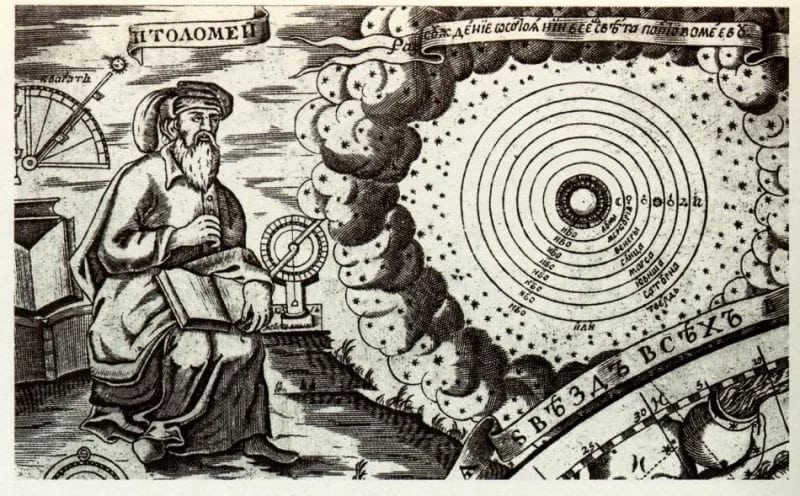
There have been numerous publications on the topic of stars, but there are a few that have significantly contributed to our modern understanding. One such publication is the renowned Almagest by Claudius Ptolemy, which was first published in 140. This comprehensive astronomical guide provides detailed insights into the celestial bodies and the ancient Greek and Middle Eastern astronomical knowledge of that era. This knowledge served as the foundation for astronomical research and theories for over 13 centuries.
It offers a comprehensive account of the universe’s structure and information about the celestial bodies. The star catalog of Hipparchus is included in the seventh and eighth books. Ptolemy himself and other astronomers from Alexandria later added the Scorpius constellation to this catalog.
6. The Javanese named the group of stars as “the pensive swan”
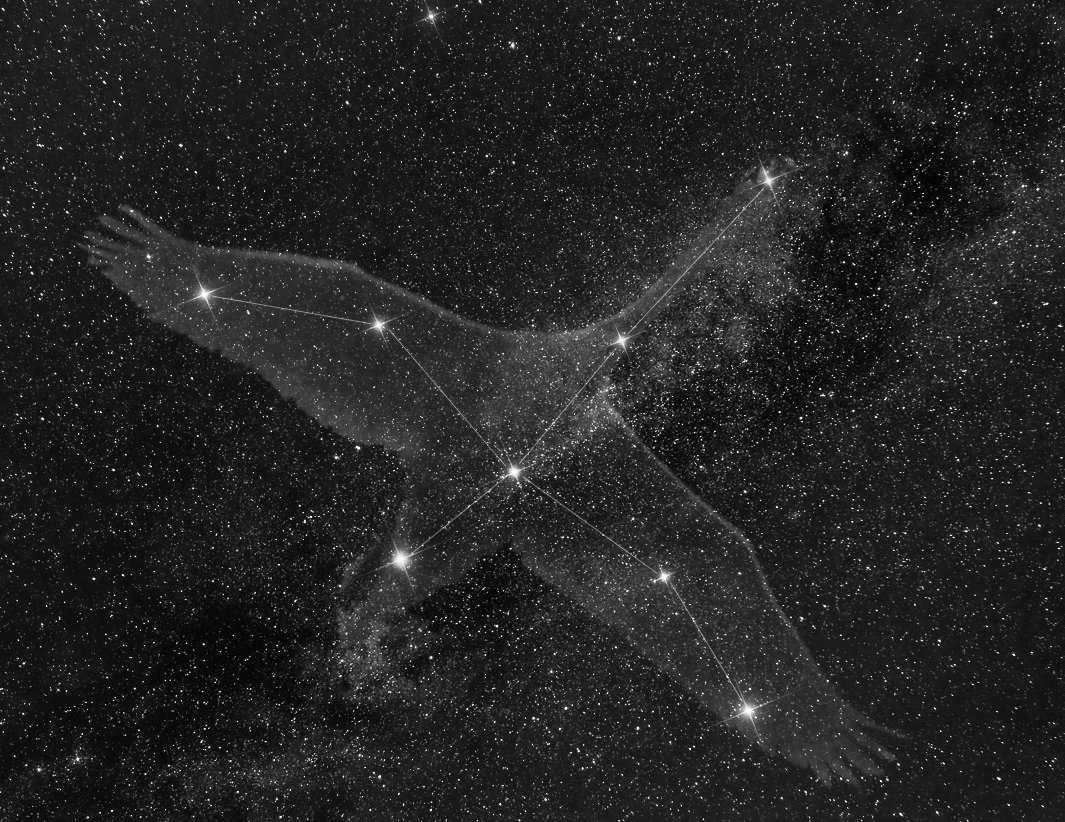
Almost all ancient civilizations named this group of stars Scorpio, except for the Javanese people. The indigenous people of Java referred to the constellation as Banyakangrem, which can be translated as "the brooding swan" or Kalapa Doyong, meaning leaning coconut palm.".
The constellation where U of Scorpius is situated
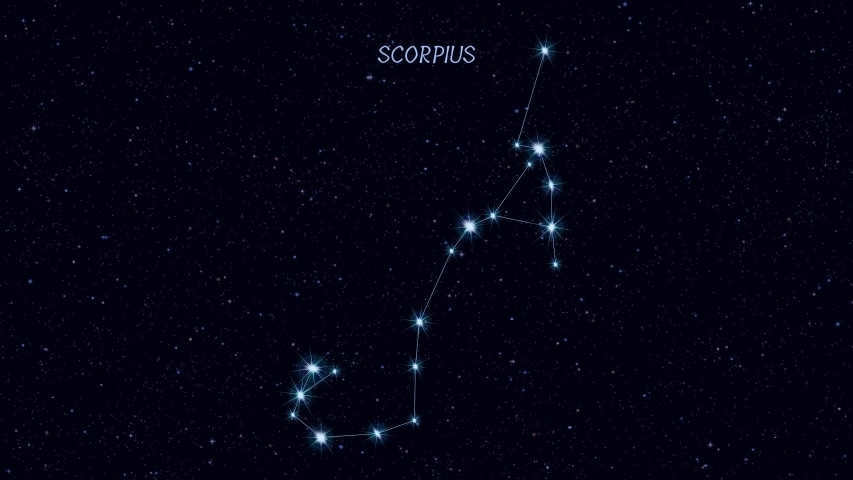
The U of Scorpio is part of a group of ten types of newly discovered stars that experience eruptions every few decades. This binary star system becomes significantly brighter during its flares, shining with a brightness that is ten times greater. The initial outburst of U Scorpius was observed in 1863, and after measuring its brightness, it remained unseen for approximately 80 years. Throughout that period, it experienced a few small flares, although they were brief in duration.
This particular star is notable for several reasons, including the number of flares it produces. The next flare is predicted to occur in 2020, although scientists have allowed for a margin of error of ± 2 years.
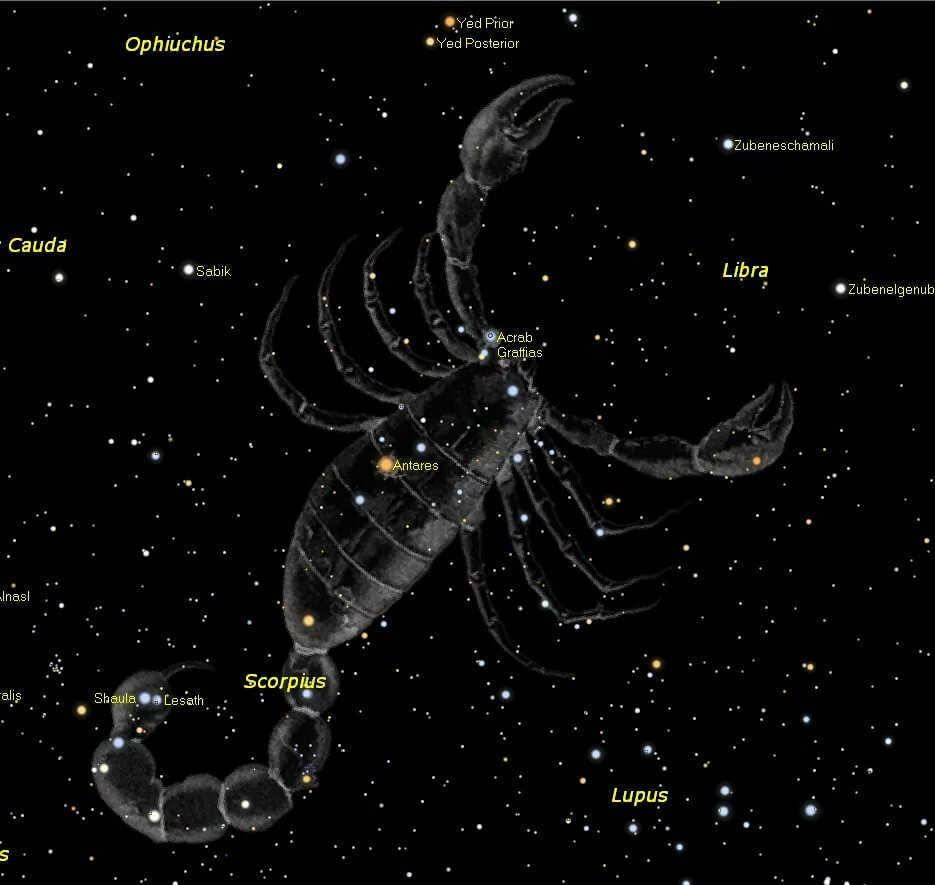
An asterism known as the sting of Scorpius is a collection of stars that have been given a separate name, even though they are part of the Scorpius constellation. The scorpion tail includes several dozen stars, but counting usually begins from Antares, which is one of the most prominent stars in the cluster.
In this case, the sting is made up of the following stars: α (Antares), τ, ε, μ, ζ, η, θ, ι, κ, λ, and ν Scorpius. The Arabs only counted four stars in the tail and referred to it as Hirtab. Modern scholars refer to it as the Fishing hook.
3. Reference to Scorpius in the “Moul Apin”, an ancient written document

The ancient text “Moul Apin” confirms that the constellations we know today have been around for at least three thousand years and have remained unchanged over time.
The constellation in question is referred to as MUL.GIR.TAB, which translates to fire sting. This name is fitting, as the arrangement of stars truly resembles the body and tail of a scorpion, a creature that people from southern regions are quite familiar with. In fact, the Aztecs even identified this constellation as a venomous spider-like creature.
2. Sacramentary and Serpentine form the boundaries of the constellation
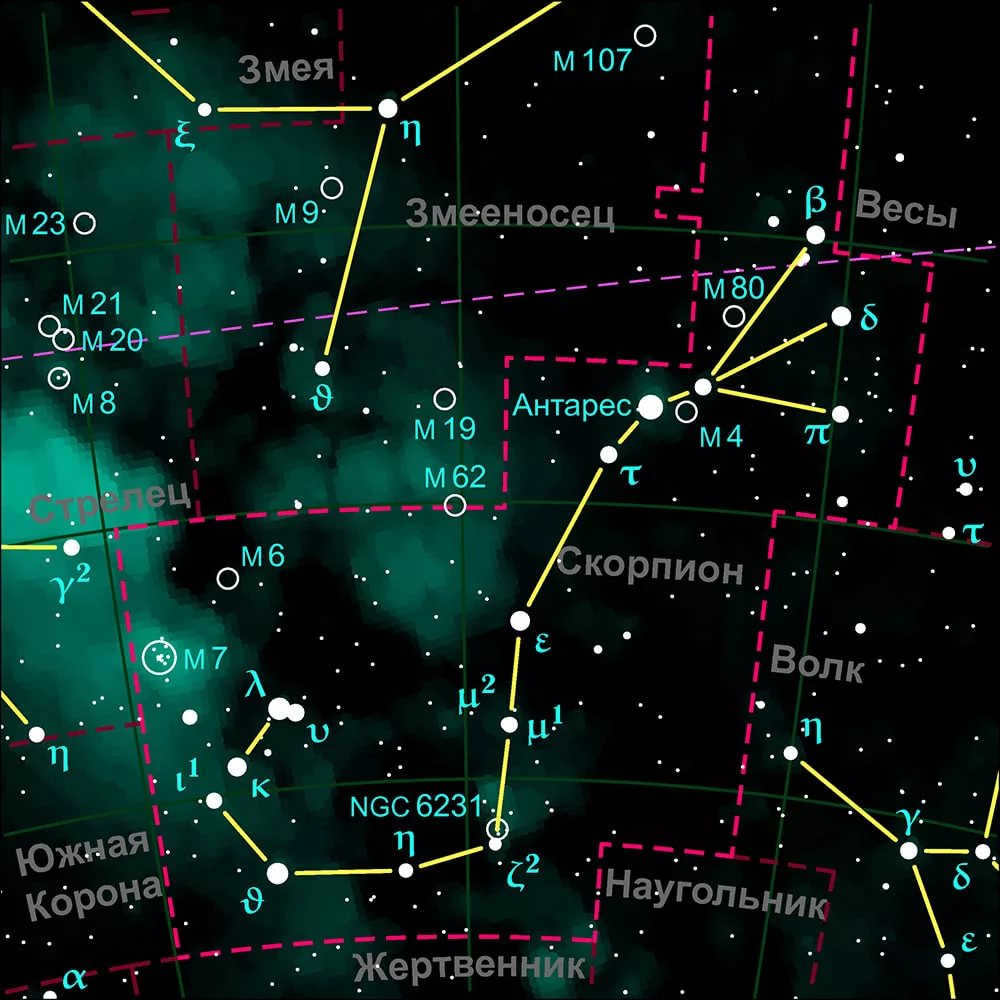
In the celestial sphere, Scorpio is situated adjacent to the constellation of Serpentine towards the north and Sacrifice towards the south. Serpentine is often referred to as the 13th zodiac sign, although it is not officially recognized as part of the Western zodiac signs despite intersecting the ecliptic. The Sacrifice is a constellation composed of numerous stars, with around 60 of them visible to the naked eye in the nighttime sky.
Furthermore, Scorpius is in close proximity to other zodiac constellations and is positioned towards the western side of the sky, fully immersed within the Milky Way – a faint, whitish band comprised of faint stars that cannot be individually discerned without specialized equipment.
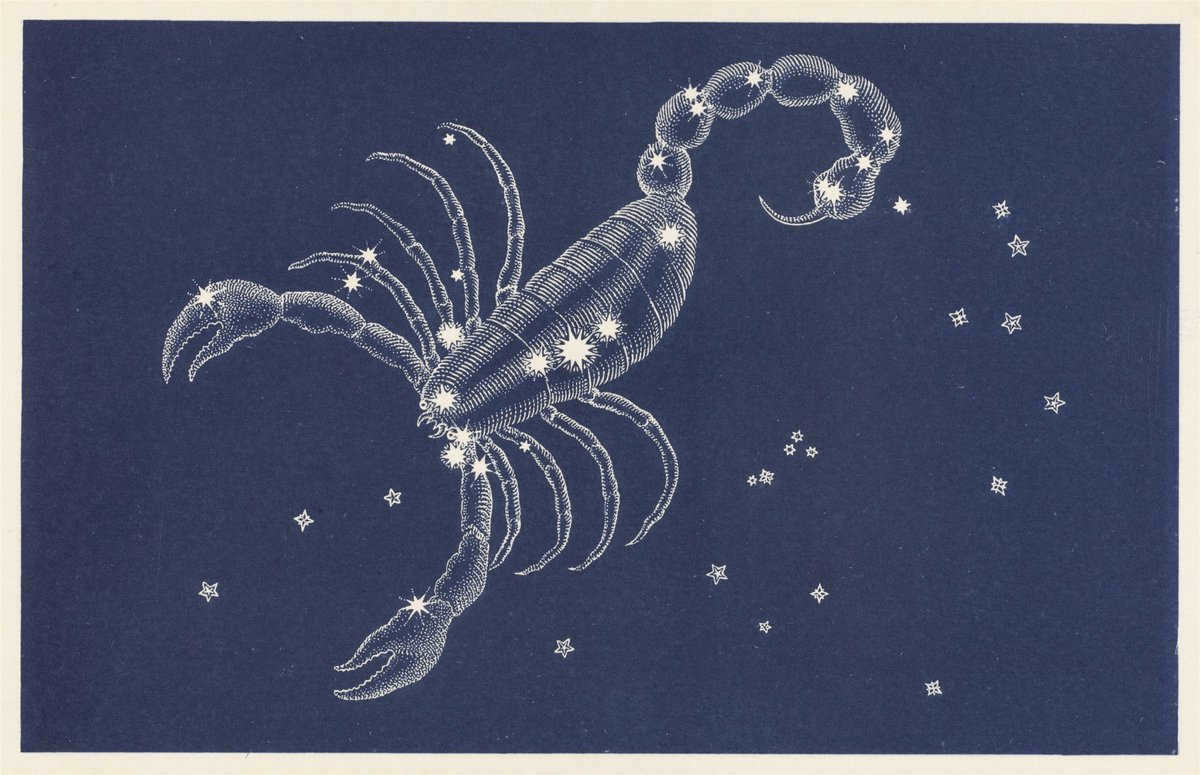
The zodiacal constellations consist of 12 constellations that form a circle around the Earth throughout the year. These constellations were originally grouped together in ancient Greece. The term “zodiacal” comes from the Greek word for “animal,” as most of the constellations are named after animals. Each constellation is associated with specific metaphysical properties that are used in the creation of horoscopes.
Individuals born between October 24 and November 22 belong to the zodiac sign Scorpio. Scorpio is a fixed Water sign. This sign is highly determined and dedicated to improving their own life and the world around them. Scorpios never cease their self-improvement efforts and will fight until they achieve victory.
Scorpio possesses great courage and resilience, unlike others who may give up easily. This sign is known for its skepticism and pessimism, always double-checking everything before making a decision. Gaining Scorpio’s trust requires passing numerous extreme tests. Those born under this sign will need to put in a lot of effort to attain their desired outcomes.
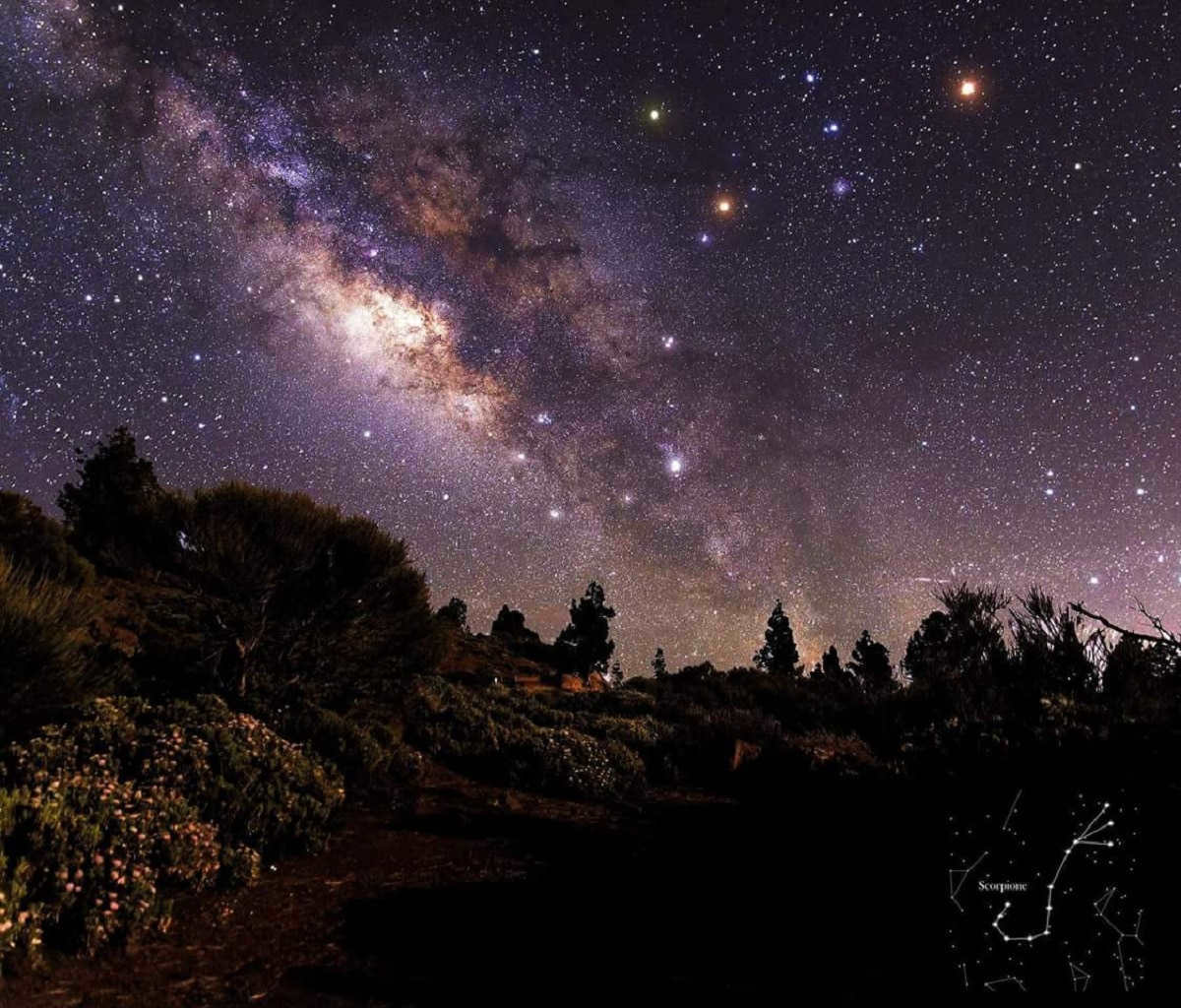
In the vast expanse of the night sky, various constellations can be observed. These constellations consist of clusters of bright stars that form shapes steeped in mythology and history. Our focus today is on the scorpion constellation. This prominent constellation resides in close proximity to the Milky Way’s center. Additionally, it is situated near the ecliptic plane, much like the other zodiac signs.
Thus, this article is dedicated to exploring the distinct characteristics, origins, mythology, and intriguing facts surrounding the Scorpio constellation.
Main features
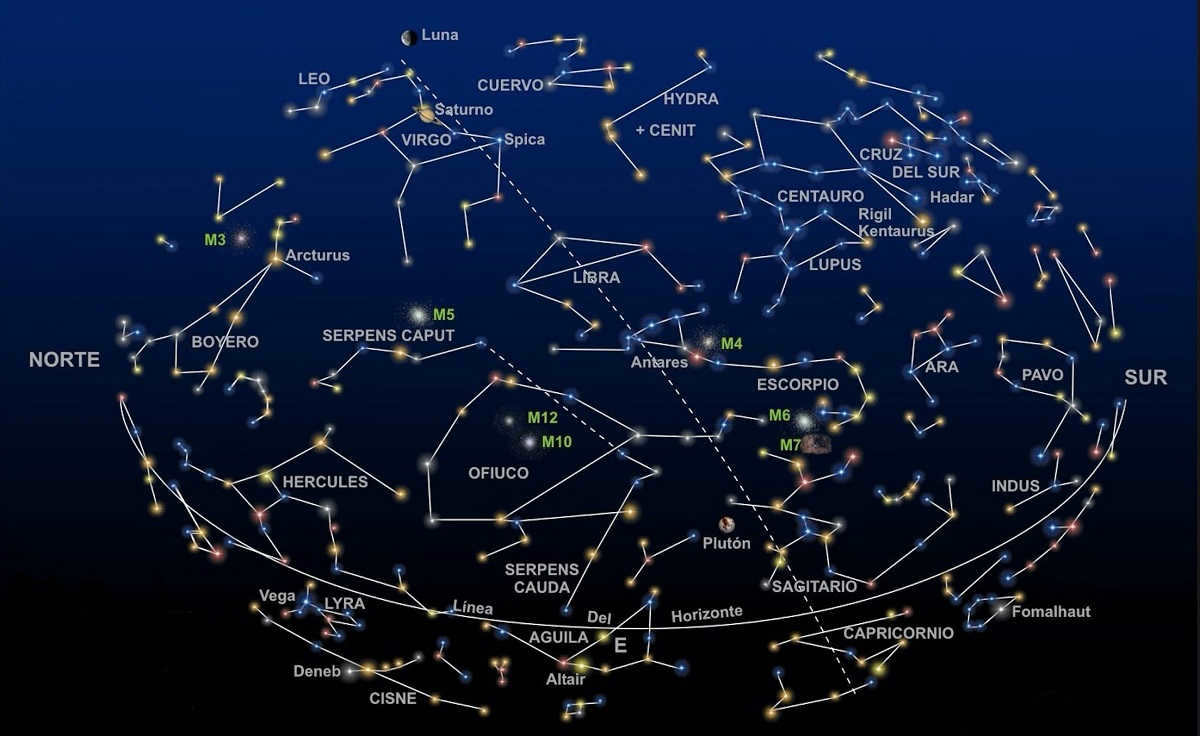
Locating this constellation is quite simple, even for beginners in stargazing. It belongs to the zodiac group and can be found between the serpentarium and the square constellations. Its name, Scorpio, comes from the fact that its brightest stars form a shape resembling a scorpion. The zodiac region refers to the portion of the sky where the ecliptic passes through and where planets can be observed. The Greeks named the constellations after real or mythological animals, which explains the name “zodiac.”
The secondary star in the Scorpius constellation has a diameter that is only double the size of the Sun. Nonetheless, it is approximately 300 times more luminous, making it visible despite its distance. Its apparent visual binary value is 1.0. Researchers have detected an exoplanet situated around 12,400 times the distance of light-years away from Earth in the Scorpius constellation. This exoplanet, also referred to as an extrasolar planet, revolves around a star that is not our Sun.
Therefore, it is a component of planetary systems other than our own. The presence of these celestial bodies has been suspected for a considerable period, although their identification did not occur until the 1990s. With advancements in technology and detection techniques, a multitude of exoplanets have been unveiled. Initially, the discovery of an exoplanet orbiting a main-sequence star occurred in 1995 when Michel Mayor and Didier Queloz of the Geneva Observatory observed 51 Pegasi b. This exoplanet possesses a mass similar to that of Jupiter. Subsequently, numerous planets have been detected by various international teams. Several of these planets reside within the Scorpius constellation, similar to the aforementioned one.
The form and location of the Scorpius constellation
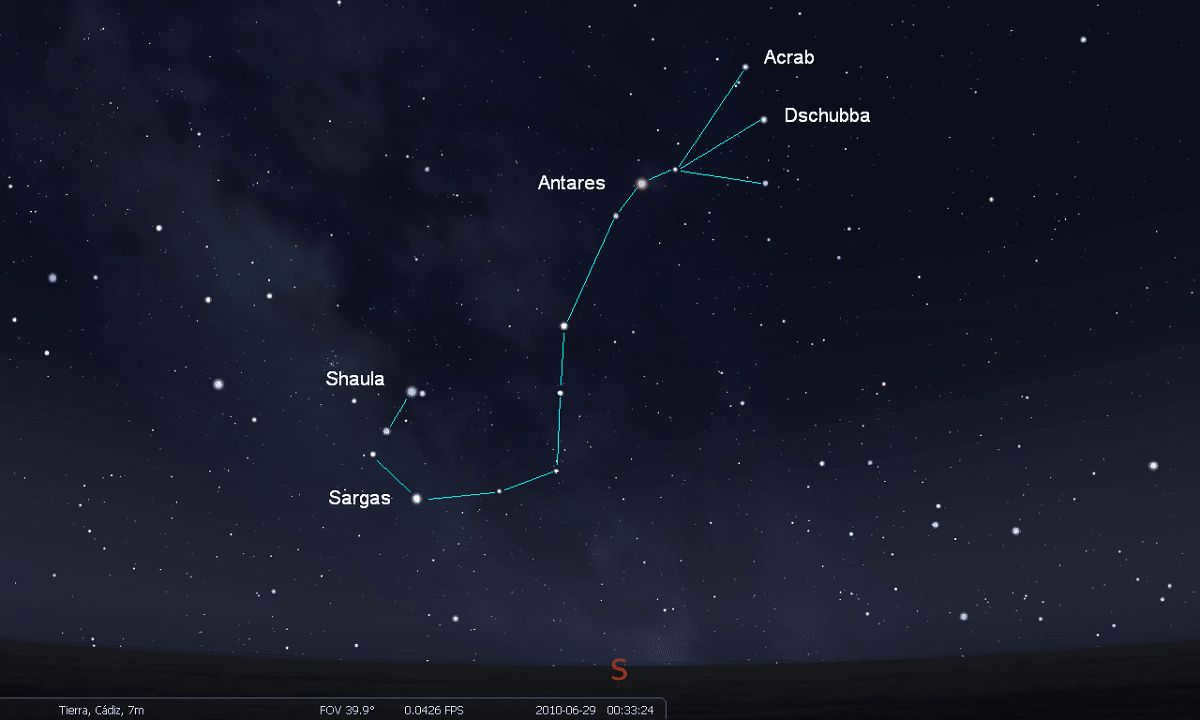
Qalbu’l-Aghrab, known as the “Heart of Scorpio” to the Arabs due to its positioning, is the brightest star in the Scorpius constellation. The Greeks named it Antares, meaning “Counter-Mars,” which is quite intriguing. This name was given because of its reddish hue and its close proximity to the planet Mars in the night sky. It is quite simple to identify the claws and sting of a scorpion by remembering the red star. This particular constellation can only be seen during the summer months and is incomplete in certain southern regions.
The Scorpius constellation contains a significant number of stars, with the 30 most notable ones listed below:
- Aqrab: Aqrab is also referred to as Grafias and exhibits a hue that is bluish-white in color.
- Dshubba: This star, which displays a bluish-white color, can be found positioned in front of the Scorpion.
- Shaula: Shaula is the name of the star located in the sting of the scorpion and positioned in front of another star known as Lesat.
- Sarja: Located at a distance of 190 light years from our planet, Sarja derives its name from Mesopotamia.
The Mythology behind the constellation Scorpio

Of course, every constellation has its own unique story. According to the tale, in order to wed Merope, the daughter of the king, the skilled hunter Orion had to eliminate all the wild creatures on the island of Chios. Unable to complete this task, the king called off the wedding. Orion was enraged, prompting him to embark on a mission to exterminate all the untamed beasts in existence.. This caused alarm for Gaia, the goddess of the Earth. To thwart Orion’s mission, she dispatched a small yet incredibly dangerous scorpion.
Notwithstanding this fact, Artemis, the deity of the chase, genuinely esteemed Orion and wished to shield him until the very end. Consequently, he managed to settle the dispute in a straightforward manner. He positioned them on opposing sides of the celestial sphere. As a result, Orion and the scorpion are now exceedingly distant from one another. They are so disassociated that they cannot be observed simultaneously.
When it comes to astrological significance, individuals born under the Scorpio sign possess a great deal of self-assurance and strong convictions. Their enthusiasm, however, can lead to feelings of jealousy and a desire for revenge. Despite this, Scorpios are known for their honesty and sincerity, making their opinions highly valuable even when they may be feeling hurt. It is worth noting that Scorpio is associated with the element of water.
Now, let us explore some interesting facts about this constellation:
- Scorpio is a constellation that contains more stars than it appears, with some having a magnitude of less than 15.
- Despite its location in the southern skies, Scorpio is often in conjunction with the Moon, providing a captivating spectacle for avid sky photographers.
- Scorpio belongs to an exclusive group of stars that share its name, as categorized by corresponding celestial bodies.





